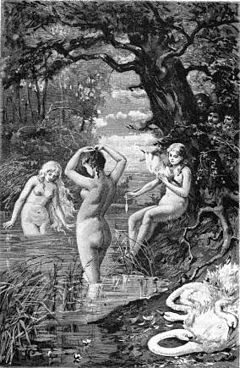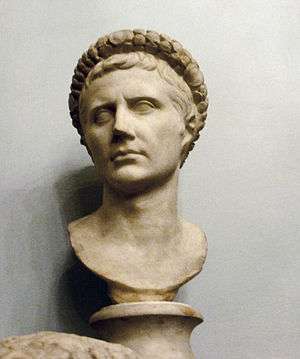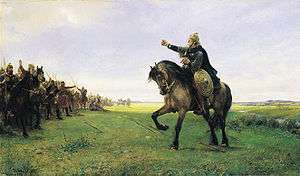Kjárr
Kjárr, or Kíarr, is a figure of Norse mythology that is believed to be the reflection of the Roman Emperors. In Old Norse sources, he appears as a king of the Valir (Celtic/Romance southerners)[2] who were the people of Valland (the Celtic/Roman south).[3]
Many scholars have suggested that the name is derived from Caesar, but the route it took to Scandinavia is not clear.[2]
Origin
In his Skáldskaparmál, Snorri Sturluson lists Kjárr as a descendant of Auði, the founder of the Ödling dynasty:
|
[...] þriði Auði, er Öðlingar eru frá komnir, [...] Af Niflunga ætt var Gjúki, af Öðlinga ætt var Kjárr, af Ylfinga ætt var Eiríkr inn málspaki.[4] |
[...] Audi, from whom the Ödlungs are come; [...] Of the Niflung's house was Gjúki; of the house of Ödlings, Kjárr; of the house of the Ylfings was Eiríkr the Wise in Speech.[5] |
In the genealogy section of Hversu Noregr byggðist, further information is provided about Auði and Kjarr. It presents Auði as the grandfather of Kjarr and as an early ruler of the Celtic/Romance southerners:
|
Auði hafði Valland ok var faðir Fróða, föður Kjárs, föður Ölrúnar.[6] |
Auði ruled Valland and was the father of Fróði, the father of Kjár, the father of Ölrún.[7] |

Kjárr and his daughter Ölrún also appear in the Völundarkviða, where she is a Valkyrie who marries the master archer Egil, the brother of Wayland the Smith:
|
Þar váru tvær dætr Hlöðvés konungs, Hlaðguðr svanhvít ok Hervör alvitr, in þriðja var Ölrún Kjársdóttir af Vallandi. Þeir höfðu þær heim til skála með sér. Fekk Egill Ölrúnar, en Slagfiðr Svanhvítrar, en Völundr Alvitrar. Þau bjuggu sjau vetr. Þá flugu þær at vitja víga ok kómu eigi aftr. Þá skreið Egill at leita Ölrúnar, en Slagfiðr leitaði Svanhvítrar, en Völundr sat í Úlfdölum. Hann var hagastr maðr, svá at menn viti, í fornum sögum.[8] |
Two of them were daughters of King Hlothver, Hlathguth the Swan-White and Hervor the All-Wise, and the third was Olrun, daughter of Kjar from Valland. These did they bring home to their hall with them. Egil took Olrun, and Slagfith Swan-White, and Völund All-Wise. There they dwelt seven winters; but then they flew away to find battles, and came back no more. Then Egil set forth on his snowshoes to follow Olrun, and Slagfith followed Swan White, but Völund stayed in Ulfdalir. He was a most skillful man, as men know from old tales.[9] |
There are two other references which both place Kjarr far back in time as a contemporary of the Huns during the Age of Migrations. One of these is a poem in the Poetic Edda named Atlakviða:
|
|
The second reference is in the Hervarar saga which contains a reference to Kíarr in a poem in fornyrðislag which lists the great kings of old:
|
The few appearances of Kjárr stand out from the general lack of references to the Romans in the literary sources of the Germanic peoples before the arrival of Christianity.[14]
Etymology
Many scholars have suggested that the name is derived from Caesar, but the route it took to Scandinavia is not clear.[2] It may have been transmitted through a West Germanic language, but since Scandinavia and the Goths had close connections, it may also have been borrowed from the Gothic language and ultimately from Greek.[2] The evolution of the name would have been καισαρ → kaisar → *kēsar → Kíarr → Kiárr.[2] A third possibility is that it originates from contacts with Rome beside the probably early borrowing Rúm in words such as Rúmverjar ("Roman soldiers").[2]
A less common theory is that it stems from Old Irish Kíarr[2] or from Cearbhall of Valland (Wales).
See also
References
- Following the Battle of the Teutoburg Forest, Augustus was the first Roman ruler to promote political alliances with "magnates" in Scandinavia, particularly Jutland. This was a reaction designed to ally with far-off Germanic people against those who were on Rome's borders. A. Forte, R. Oram, and F. Pederson. Viking Empires. Cambridge: Cambridge University Press, 2005 ISBN 0-521-82992-5. pp. 14-25.
- Anderson, Carl Edlund. (1999). Formation and Resolution of Ideological Contrast in the Early History of Scandinavia. Ph.D. thesis, University of Cambridge, Department of Anglo-Saxon, Norse & Celtic (Faculty of English). p. 44. Archived 2007-03-07 at the Wayback Machine
- The entry Valnöt in Svensk etymologisk ordbok by Elof Hellquist (1922).
- Skáldskaparmál, at Norrøne Tekster og Kvad, Norway.
- Skáldskaparmál, in translation by Arthur Gilchrist Brodeur (1916).
- Ættartölur, a section of Flateyjarbók at «Norrøne Tekster og Kvad», Norway.
- Translation provided by Wikipedia editors.
- Völundarkviða at «Norrøne Tekster og Kvad», Norway. Archived 2007-05-08 at the National and University Library of Iceland
- Henry A. Bellows' translation of The Lay of Völund.
- Atlakviða, at «Norrøne Tekster og Kvad», Norway. Archived 2007-05-08 at the National and University Library of Iceland
- The Lay of Atli Translated by William Morris and Eirikr Magnusson. Archived 2005-05-27 at the Wayback Machine
- The Poem Heiðr 89 at the database "Skaldic Poetry of the Scandinavian Middle Ages".
- "Tunstall's English translation of the Hervarar saga, at Northvegr". Archived from the original on 2006-05-11. Retrieved 2007-01-27.
- Anderson, Carl Edlund. (1999). Formation and Resolution of Ideological Contrast in the Early History of Scandinavia. Ph.D. thesis, University of Cambridge, Department of Anglo-Saxon, Norse & Celtic (Faculty of English). p. 45. Archived 2007-03-07 at the Wayback Machine

